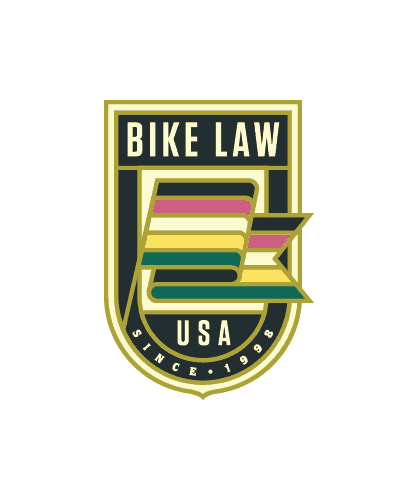It’s important to know your legal rights (and duties) when bicycling in California. It is especially important after a bicycle accident (we call them bicycle “crashes” and explain why here).
This is a general overview of California’s bicycle laws. To see them in their completion, please visit California’s Department of Transportation. Feel free to reach out to Bike Law’s National Director Rachael Maney for further information.
Right to the Road
Bicycles are not defined as vehicles but generally have the same rights and responsibilities as motor vehicle drivers.
Where to Ride
- Bicyclists are required to ride as far to the right as practicable, when traveling at a speed less than traffic.
- Full lane use is allowed when traveling at the normal speed of traffic or there is no traffic, preparing for a turn, overtaking and passing, avoiding hazards or unsafe conditions, traveling in a lane too narrow to share, and avoiding a mandatory turn lane or right hook.
- Bicyclists on one way roads with two or more lanes of traffic, bicyclists may ride as near to the left-hand curb or edge as practicable.
- Bicyclists traveling at a speed less than traffic are required to ride within the bicycle lane, when available, except if the bicyclist is overtaking or passing, preparing for a turn, avoiding hazards and debris and avoiding mandatory turn lanes.
- Sidewalk riding is generally permissible, but bicyclists must yield right-of-way to pedestrians. Check local ordinances for variations on this rule.
HOW TO RIDE
- Bicyclists may ride two abreast or more when traveling at the normal speed of traffic and not impeding traffic or if they are traveling in a lane too narrow to share with motor vehicles.
- If bicyclists are not traveling at the normal speed of traffic or the bicyclists are impeding traffic with five (5) or more motor vehicles behind them, then the bicyclists must ride single file.
- Bicyclists are required to slow down and come to a complete stop at stop signs and traffic devices signaling red.
- Bicyclists must signal when turning or coming to a stop.
Bicyclists Overtaking Cars
Bicyclists on roadways must exercise due care when passing a standing vehicle or one proceeding in the same direction.
Cars Overtaking Bicyclists
Motor vehicle drivers are required to pass bicyclists at a distance of no less than three (3) feet. Cars must not interfere with the safe operation of bicycles.
Equipment
- Bicyclists under the age of 18 are required to wear a properly fastened helmet.
- At night, a bicycle must be equipped with a front white light, visible from the front and a rear red reflector, visible from the back. Bicyclists may use a solid or flashing light on the back in addition to the reflector.
- At night, bicycles must have a white or yellow reflectors on each pedal or on the bicyclist’s shoes or ankles, which must be visible from the front.
- At night, bicycles must have white or yellow reflector on the front half of the bicycle and a red and white reflector on each side of the back half of the bike. The reflectors are not required if the bike has reflectorized front and back tires.
- Every bicycle must have a brake system which will execute a one-braked-wheel skid on dry, level, clean pavement.
Prohibitions
- No one may stop on or park a bicycle on a bicycle path or sidewalk.
- Bicyclists (including motorized bicycles) may not cross toll bridges, freeways, and expressways unless otherwise permitted by CA DOT.
- A bicycle may not carry more than the number of persons for which it is designed.
- Bicyclists may not ride a bicycle without having at least one hand on the handlebars and handlebars must not be higher than the rider’s shoulders.
- Bicyclists may not operate a bicycle without a permanent, regular seat, unless designed by the manufacturer to be ridden without a seat.
- Bicycle passengers weighing less than 40 lbs. must have a seat which keeps them in place and protects them from moving parts.
- Bicyclists may not operate bicycles with fixed gears and no brakes, no matter how skilled the rider.
- Bicyclists may not operate bicycles that are too large to stop, support it with one foot on the ground, and start safely.
- Bicyclists may not wear earplugs in both ears or a headset covering both ears; however, hearing aids are allowed.
- Clinging to motor vehicles while bicycling is not permitted.
- Bicycles must be operated with at least one hand on handlebars.
Alcohol
Bicyclists may not ride while under the influence of alcohol or drugs.
